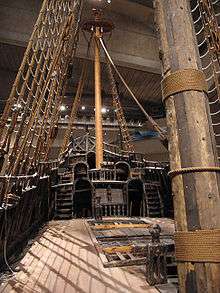Taffrail
In naval architecture a taffrail is the handrail around the open deck area toward the stern of a ship or boat. The rear deck of a ship is often called the afterdeck or poop deck. Not all ships have an afterdeck or poop deck. Sometimes taffrail refers to just curved wooden top of the stern of a sailing man-of-war or East Indiaman ship. The rail of these wooden sailing ships usually had hand carved wood rails, often highly decorated.[1] Sometimes taffrail refers to complete deck area at the stern of a vessel.[2][3][4][5]
A taffrail log is a mechanical speed logging device, used like a car odometer. The taffrail log was towed from the stern or taffrail of the ship by a long line. Taffrail log were developed in the eighteenth century and became a practical device in the nineteenth century. [6]
Gallery
.png) Taffrail (#1)
Taffrail (#1) William Heysmann Overend painting: Naval Captain on the Poop deck taffrail
William Heysmann Overend painting: Naval Captain on the Poop deck taffrail Weather deck of the Swedish 17th-century warship Vasa looking aft toward the sterncastle, with a hand carved taffrail
Weather deck of the Swedish 17th-century warship Vasa looking aft toward the sterncastle, with a hand carved taffrail.jpg) Gdańsk "Lew" a seventeenth century galleon replica, stern with wooden carved taffrail
Gdańsk "Lew" a seventeenth century galleon replica, stern with wooden carved taffrail Prins Willem stern with wooden carved taffrail
Prins Willem stern with wooden carved taffrail- Star of India stern taffrail
See also
References
- ↑ Getty Images, Taffrail Pictures and Images
- ↑ Directions for laying off ships on the mouldloft floor, page 80, By John Fincham
- ↑ Naval Architecture, Or, The Rudiments and Rules of Ship Building, page 111, By Marmaduke Stalkartt
- ↑ Royal, National Maritime Museum, Taffrail carving; horses head
- ↑ The Nautical Magazine for 1875, page 491
- ↑ My stic seaport, taffrail log